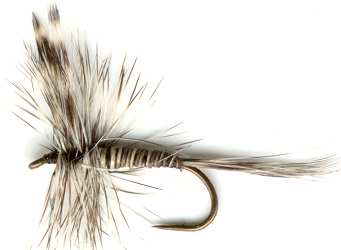The Mosquito Dry Fly
You may not like the blood sucking Mosquito but trout do. You should have this fly pattern in your fly-box when fishing for trout.

DRY FLY PATTERNS. Hook size 12 14 16 18 20 24 - $US each
I hate mosquitoes. When they stick their nose into your skin and suck your blood its painful but the worst period is the following two days when the bite becomes itchy. You so desperately want to scratch but know what will happen. It is torture from hell. In some areas trout seem to prefer to eat midges that the larger mosquito therefore this insect has been rather over looked by fly fishermen. These insects do fall into the water and get trapped in the surface film. The prospect of a bigger meal can cause the trout to attack. If you are waiting for a midge or mayfly hatch then tie on a mosquito and give it a try.
I have found the Mosquito Fly Pattern in the right size works well when Female midges return to the water surface to lay their eggs. The segmented appearance of the body looks similar to the body of the natural insect. Adult midges are an important evening food source for stillwater trout. Try to match the size of the natural Chironomid Midge. In early spring black midges can be the first insects to appear. Brown, ginger and olive midges normally appear later in the year.
With catch and release becoming more popular certain waters will contain battle hardened trout that have survived numerous fights with anglers. This is especially true in heavily fished waters. These trout are now always on the look out for suspicious looking food that does not look like the natural insect or behave normally. They are even rejecting natural insects, that have a damaged tail or wing, just in case it has a hook attached. They will allow other trout to feed first, when the mayflies appear, and see what happens before they start munching. In these circumstances you will need to use a fly that is an imitation of the natural insect and not an attractor pattern. You will have to choose your fishing location with skill. If it sees movement it will be spooked. Find a spot that offers some natural cover. Dusk can help catch these large cunning trout. As the light fades it is not as easy for the trout to spot an imitation fly.


Fly Fishing books

